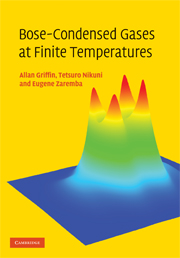Book contents
- Frontmatter
- Contents
- Preface
- 1 Overview and introduction
- 2 Condensate dynamics at T = 0
- 3 Coupled equations for the condensate and thermal cloud
- 4 Green's functions and self-energy approximations
- 5 The Beliaev and the time-dependent HFB approximations
- 6 Kadanoff–Baym derivation of the ZNG equations
- 7 Kinetic equation for Bogoliubov thermal excitations
- 8 Static thermal cloud approximation
- 9 Vortices and vortex lattices at finite temperatures
- 10 Dynamics at finite temperatures using the moment method
- 11 Numerical simulation of the ZNG equations
- 12 Simulation of collective modes at finite temperature
- 13 Landau damping in trapped Bose-condensed gases
- 14 Landau's theory of superfluidity
- 15 Two-fluid hydrodynamics in a dilute Bose gas
- 16 Variational formulation of the Landau two-fluid equations
- 17 The Landau–Khalatnikov two-fluid equations
- 18 Transport coefficients and relaxation times
- 19 General theory of damping of hydrodynamic modes
- Appendix A Monte Carlo calculation of collision rates
- Appendix B Evaluation of transport coefficients: technical details
- Appendix C Frequency-dependent transport coefficients
- Appendix D Derivation of hydrodynamic damping formula
- References
- Index
6 - Kadanoff–Baym derivation of the ZNG equations
Published online by Cambridge University Press: 06 October 2009
- Frontmatter
- Contents
- Preface
- 1 Overview and introduction
- 2 Condensate dynamics at T = 0
- 3 Coupled equations for the condensate and thermal cloud
- 4 Green's functions and self-energy approximations
- 5 The Beliaev and the time-dependent HFB approximations
- 6 Kadanoff–Baym derivation of the ZNG equations
- 7 Kinetic equation for Bogoliubov thermal excitations
- 8 Static thermal cloud approximation
- 9 Vortices and vortex lattices at finite temperatures
- 10 Dynamics at finite temperatures using the moment method
- 11 Numerical simulation of the ZNG equations
- 12 Simulation of collective modes at finite temperature
- 13 Landau damping in trapped Bose-condensed gases
- 14 Landau's theory of superfluidity
- 15 Two-fluid hydrodynamics in a dilute Bose gas
- 16 Variational formulation of the Landau two-fluid equations
- 17 The Landau–Khalatnikov two-fluid equations
- 18 Transport coefficients and relaxation times
- 19 General theory of damping of hydrodynamic modes
- Appendix A Monte Carlo calculation of collision rates
- Appendix B Evaluation of transport coefficients: technical details
- Appendix C Frequency-dependent transport coefficients
- Appendix D Derivation of hydrodynamic damping formula
- References
- Index
Summary
In Chapter 4, we introduced the Kadanoff–Baym equations of motion for the imaginary-time nonequilibrium Green's functions for a Bose gas, as given by (4.59) and (4.60). In this chapter, we will use the generalization of these equations of motion to find the equivalent equations of motion for the real-time Green's functions. These can be written in a natural way in the form of a kinetic equation. Using a simple Hartree–Fock approximation, we show how the coupled equations for the condensate and thermal cloud given in Chapter 3 emerge naturally from the Kadanoff–Baym (KB) formalism. This chapter is based on Imamović-Tomasović and Griffin (2001) and Imamović-Tomasović (2001), building on the pioneering work of Kane and Kadanoff (1965).
In this chapter and Chapter 7 we review the KB formalism. However, we also encourage the reader to read the original account given by Kadanoff and Baym (1962). The goals and accomplishments of their seminal book are beautifully captured by the following quote from p. 138:
Our rather elaborate Green's function arguments provide a means of describing transport phenomena in a self-contained way, starting from a dynamical approximation, i.e. an approximation for G2(U) in terms of G1(U). These calculations require no extra assumptions. The theory provides at the same time a description of the transport processes that occur and a determination of the quantities which appear in the transport equations.
A closely related way of treating the nonequilibrium dynamics of a Bose-condensed gas is based on the two-particle irreducible (2PI) effective action together with the Schwinger–Keldysh closed-time path formalism. Berges (2004) gives a detailed review of this approach, which allows one to derive the nonequilibrium action on the basis of controllable approximations.
- Type
- Chapter
- Information
- Bose-Condensed Gases at Finite Temperatures , pp. 107 - 128Publisher: Cambridge University PressPrint publication year: 2009



